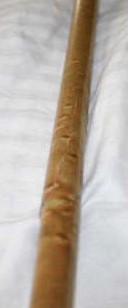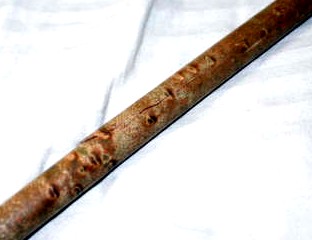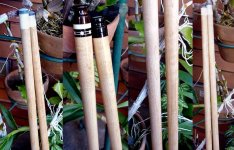You are using an out of date browser. It may not display this or other websites correctly.
You should upgrade or use an alternative browser.
You should upgrade or use an alternative browser.
Maple Shaft Color Differences
- Thread starter TATE
- Start date
TATE said:Does anyone really know why the shaft wood maple used in the old days was darker than the current stuff?
I thought it was the drying process, but now I wonder of the species of maple harvested is just whiter wood.
Chris
It has to do mainly with the drying, cutting and storing process. If the Maple is cut while the sap is in it, it will be darker. Most wood cut for the cue industry is cut in the winter. Maple left on the log for too long before cutting takes on a darker colour than normal. The vacuum process of drying leaves the wood whiter than it did in the past.
Thnx.Mase said:It has to do mainly with the drying, cutting and storing process. If the Maple is cut while the sap is in it, it will be darker. Most wood cut for the cue industry is cut in the winter. Maple left on the log for too long before cutting takes on a darker colour than normal. The vacuum process of drying leaves the wood whiter than it did in the past.
Somehow people think the whiter the shaft wood the better.
If you let the average person pick a shaft between a white one and a brownish one, he'd pick the white one right away. Even if the brownish one is stiffer and has better tone.
Would the vacuum kilning process soften maple?
Mase said:It has to do mainly with the drying, cutting and storing process. If the Maple is cut while the sap is in it, it will be darker. Most wood cut for the cue industry is cut in the winter. Maple left on the log for too long before cutting takes on a darker colour than normal. The vacuum process of drying leaves the wood whiter than it did in the past.
Thanks for the information.
I gather that more cue makers request the white stuff now, so the industry responded by producing whiter wood?
Is most of the shaft wood vacuum dried now? Would you say the vacuum drying process weakens the wood? It sure seems to me that the white shaft wood is not as dense as the old stuff.
Chris
Not the cue industry. The trend begun with the larger quantity consuming industries like the furniture, flooring and door/cabinet industry. When the $ weakened, most of the manufacturing moved overseas to developing economies. Other entrepreneurs, in this developing nation, picked up on the newly opened market thus manufacturing facilities for these products started appearing all over the place. More manufacturers mean higher demand for raw materials. And with the stronger currency, higher volume of raw materials started shipping out of North America.TATE said:Thanks for the information.
I gather that more cue makers request the white stuff now, so the industry responded by producing whiter wood?
It sure seems to me that the white shaft wood is not as dense as the old stuff.
Chris
It's a good thing that the US Logging and Timber industry started the "Managed Stands" program. Had it not, the US forest will be turned into grasslands (not the variety that brings higher revenue
This is the reason for the current product. It started as a trend, whiter looks cleaner, that ended up being a standard. It was a trend that came about from the flooring, cabinets and furniture (oh and children toys) consumers demand.
To the custom cuemaking industry and its consumers, this trend makes for an aesthetically pleasing product. But the more important characteristic, performance, is a hit or miss affair.
In a way it helped in the development of cuecrafting. Searching for or inventing cue function compatible materials/products bring out the ingenuity and resolve of the cuecraftsman. The knowledgeable consumer wins.
PoolSleuth
Banned
Great question Chris Also I will ask as I have recently SEEN some shaft made of a Maple that RESEMBLES FIDDLEBACK, or TIGER STRIPED MAPLE, is there any know advantage to the use of the Fancy Maple.... Or is it just Fluff, and Pretty.....
Also I will ask as I have recently SEEN some shaft made of a Maple that RESEMBLES FIDDLEBACK, or TIGER STRIPED MAPLE, is there any know advantage to the use of the Fancy Maple.... Or is it just Fluff, and Pretty.....
PoolSleuth said:Great question ChrisAlso I will ask as I have recently SEEN some shaft made of a Maple that RESEMBLES FIDDLEBACK, or TIGER STRIPED MAPLE, is there any know advantage to the use of the Fancy Maple.... Or is it just Fluff, and Pretty.....
I can speak from my experiences. Curly yes, birdseye no.
I have had a number of maple shafts with figure in them. A shaft can be made from curly or fiddleback with success. I think quilted might make an interesting shaft. The few shafts I have seen made from figured maple on old cues are stuill beautifully straight and indeed beautiful. Here is a cue made in 1965 or so with an original curly maple shaft and it is perfectly straight - it's the model 9 on the upper left hand corner:
http://www.palmercollector.com/Model9s.html
The interesting things is, this particular cue was an early Palmer converted from a one one piece full splice Brunswick ebony cue, possibly a Titlist or a 26 1/2. So you can see the forearm had some figure that carried into the shaft. This is very rare in a Titlist.
On the other hand, a shaft is too thin to be made reliably with birdseye. Birdeye is brittle, and a shaft has to bend. Birdseye shafts will shatter and break eventually.
So , the wood has to be selected carefully. It must be flexible, strong, relatively hard, and retain its shape well to be good shaft wood.
Chris
Ps. I would like to mention to all cue-makers out there. If you can save the original shaft from a one piece conversion like the Model 9 is , do it. It's a wonderful feeling to see the match of the shaft and forearm like this cue - it makes it "special".
Last edited:
bandido said:Not the cue industry. The trend begun with the larger quantity consuming industries like the furniture, flooring and door/cabinet industry. When the $ weakened, most of the manufacturing moved overseas to developing economies. Other entrepreneurs, in this developing nation, picked up on the newly opened market thus manufacturing facilities for these products started appearing all over the place. More manufacturers mean higher demand for raw materials. And with the stronger currency, higher volume of raw materials started shipping out of North America.
It's a good thing that the US Logging and Timber industry started the "Managed Stands" program. Had it not, the US forest will be turned into grasslands (not the variety that brings higher revenue).
This is the reason for the current product. It started as a trend, whiter looks cleaner, that ended up being a standard. It was a trend that came about from the flooring, cabinets and furniture (oh and children toys) consumers demand.
To the custom cuemaking industry and its consumers, this trend makes for an aesthetically pleasing product. But the more important characteristic, performance, is a hit or miss affair.
In a way it helped in the development of cuecrafting. Searching for or inventing cue function compatible materials/products bring out the ingenuity and resolve of the cuecraftsman. The knowledgeable consumer wins.
Thanks Edwin - good info.
Maple is a very popular cabinet and flooring wood right now now in the USA. Oak was very popular, but now maple and cherry seem to be the hot item.
In the US, we have gone through a home building and remodeling boom the last several years because of cheap loans and high real estate values. I am sure that is draining the wood supply and driving up prices. I understand the building in China is also driving up supply costs.
Chris
Actually, I was referring to the 80s building and remodeling boom specially in California and the NorthEast. The Taiwan (before China) made components started coming in the early 90s. I remembered because I built a house and managed and maintained my former that I turned into a rental. I noticed the increase of Taiwan-made products in Home Depot.TATE said:Thanks Edwin - good info.
Maple is a very popular cabinet and flooring wood right now now in the USA. Oak was very popular, but now maple and cherry seem to be the hot item.
In the US, we have gone through a home building and remodeling boom the last several years because of cheap loans and high real estate values. I am sure that is draining the wood supply and driving up prices. I understand the building in China is also driving up supply costs.
Chris
Now...they even have floating sawmills! Logs are cut, dimensioned and kilned in the ships on the way back to Asia. They load logs and unload ready to use lumber.
The striped variety that you see in shafts aren't really of the fiddleback/curly (descriptive term referring to LOOKS) variety. The shaft material that you refer to have compression rings (descriptive term referring to MECHANICAL/STRUCTURAL PROPERTIES)brought about by the weight and age of the tree that they came from. They're denser/stiffer than the plain variety for the reason stated on how they came to be. I beg to differ with the birdseye variety as it also has the shaft compatible version as the curly variety. Just have to know the tell-tale signs when choosing boards.
Last edited:
TATE said:I can speak from my experiences. Curly yes, birdseye no.
I have had a number of maple shafts with figure in them. A shaft can be made from curly or fiddleback with success. I think quilted might make an interesting shaft. The few shafts I have seen made from figured maple on old cues are stuill beautifully straight and indeed beautiful. Here is a cue made in 1965 or so with an original curly maple shaft and it is perfectly straight - it's the model 9 on the upper left hand corner:
http://www.palmercollector.com/Model9s.html
The interesting things is, this particular cue was an early Palmer converted from a one one piece full splice Brunswick ebony cue, possibly a Titlist or a 26 1/2. So you can see the forearm had some figure that carried into the shaft. This is very rare in a Titlist.
On the other hand, a shaft is too thin to be made reliably with birdseye. Birdeye is brittle, and a shaft has to bend. Birdseye shafts will shatter and break eventually.
So , the wood has to be selected carefully. It must be flexible, strong, relatively hard, and retain its shape well to be good shaft wood.
Chris
Ps. I would like to mention to all cue-makers out there. If you can save the original shaft from a one piece conversion like the Model 9 is , do it. It's a wonderful feeling to see the match of the shaft and forearm like this cue - it makes it "special".
It is very rare, but I think sometimes birdseye comes in the form of very very small eyes, very tight...so small to be overlooked sometimes. I believe shafts have successfully been made from them. Bandido would know I think.
There may be more grain tear out in birdseye vs nonfigured hard maple, but I did not know it was brittle. I have some very dense birdseye (small portions of it are pushing 50 grains per inch), and it doesn't seem brittle.
That one shaft you posted a pic of with the curls is very nice. I have an It's George shaft that has some compression curls (nothing like yours). It seems to play a little better than the other shaft.
I think quilted figure is practically unheard of in hard maple.
Kelly
Kelly_Guy said:There may be more grain tear out in birdseye vs nonfigured hard maple, but I did not know it was brittle. I have some very dense birdseye (small portions of it are pushing 50 grains per inch), and it doesn't seem brittle.
Kelly
Here's are a couple of pics of a birdseye shaft that failed. I don't know how it happened (the photos were sent to me) but the split starts at a section of heavy figure and goes up the middle of the shaft.. We've all seen "smiles" where birdseye or curly splits.
I think a tight birdseye would be fine. This stuff has pretty heavy figure.


PoolSleuth
Banned
THe Eye of the Birdseye as I understand it is a Knot, or Where a Limb Attached to the TRUNK. I can see where it would not stand up to the Punishment a Shaft GETS....
The birdseye material used for the shafts that you show are more for looks. Kelly knows the type used for shafts and it too is what I'm referring to.
Notice the part where Kelly goes "very tight....", that continues as "very tight straight grain". "So small that it can sometimes be overlooked" is another key characteristic. The eye on this type is 10x smaller than the eye on what you show plus you may actually be able to count the quantity in a shaft.
"Torture" set's break cue has one.
Kelly_Guy : It is very rare, but I think sometimes birdseye comes in the form of very very small eyes, very tight...so small to be overlooked sometimes. I believe shafts have successfully been made from them.
Notice the part where Kelly goes "very tight....", that continues as "very tight straight grain". "So small that it can sometimes be overlooked" is another key characteristic. The eye on this type is 10x smaller than the eye on what you show plus you may actually be able to count the quantity in a shaft.
"Torture" set's break cue has one.
BE Shafts
I have some of those BE shafts... stiff and solid. The eyes are really small. I took some pics but its hard to see them. I did manage to find 2 that I think will show the eyes. Am not a good photographer so you can imagine my difficulty... here goes...
I have some of those BE shafts... stiff and solid. The eyes are really small. I took some pics but its hard to see them. I did manage to find 2 that I think will show the eyes. Am not a good photographer so you can imagine my difficulty... here goes...
Attachments
Last edited:
The shafts are indeed ok and I like them a lot.
Re the picture: I did play around with photoshop (brightness, contrast and color balance... and a little sharpening) to try and enhance the eyes so that it would come out visible in the computer/picture. My other shaft has even smaller eyes but I can't seem to bring them out correctly on the pic. Nice inputs on the thread as always.
Re the picture: I did play around with photoshop (brightness, contrast and color balance... and a little sharpening) to try and enhance the eyes so that it would come out visible in the computer/picture. My other shaft has even smaller eyes but I can't seem to bring them out correctly on the pic. Nice inputs on the thread as always.
